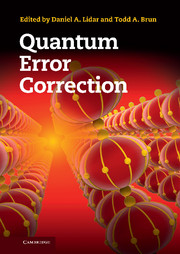Book contents
- Frontmatter
- Contents
- List of contributors
- Prologue
- Preface and guide to the reader
- Acknowledgements
- Part I Background
- Part II Generalized approaches to quantum error correction
- Part III Advanced quantum codes
- Part IV Advanced dynamical decoupling
- Part V Alternative quantum computation approaches
- Part VI Topological methods
- 19 Topological codes
- 20 Fault-tolerant topological cluster state quantum computing
- Part VII Applications and implementations
- Part VIII Critical evaluation of fault tolerance
- References
- Index
20 - Fault-tolerant topological cluster state quantum computing
from Part VI - Topological methods
Published online by Cambridge University Press: 05 September 2013
- Frontmatter
- Contents
- List of contributors
- Prologue
- Preface and guide to the reader
- Acknowledgements
- Part I Background
- Part II Generalized approaches to quantum error correction
- Part III Advanced quantum codes
- Part IV Advanced dynamical decoupling
- Part V Alternative quantum computation approaches
- Part VI Topological methods
- 19 Topological codes
- 20 Fault-tolerant topological cluster state quantum computing
- Part VII Applications and implementations
- Part VIII Critical evaluation of fault tolerance
- References
- Index
Summary
Introduction
Cluster states were introduced in Chapter 18, along with some of the approaches to achieving fault tolerance in measurement-based quantum computing. In this chapter, we describe an extremely promising fault-tolerant cluster state quantum computing scheme [RH07, RHG07] with a threshold error rate of 7.46 × 10−3, low overhead arbitrarily long-range logical gates and novel adjustable strength error correction capable of correcting general errors through the correction of Z errors only. Detailed proposed implementations of this scheme exist for ion traps [SJ09] and single photons with cavity mediated interactions [DGI+07].
The discussion is organized as follows. In Section 20.2, we describe the topological cluster state, which is a specific three-dimensional (3D) cluster state, and give a brief overview of what topological cluster state quantum computing involves. Section 20.3 describes logical qubits in more detail and how to initialize them to ∣0L〉 and ∣+L〉 and measure them in the ZL and XL bases. State injection, the non-fault-tolerant construction of arbitrary logical states, is covered in Section 20.4. Logical gates, namely the logical identity gate and the logical CNOT gate, are discussed in Section 20.5 along with their byproduct operators. Section 20.6 describes the errorcorrection procedure. In Section 20.7, we calculate an estimate for the threshold of this scheme.
Section 20.8 presents an analysis of the overhead as a function of both the circuit size and the error rate.
- Type
- Chapter
- Information
- Quantum Error Correction , pp. 482 - 506Publisher: Cambridge University PressPrint publication year: 2013



